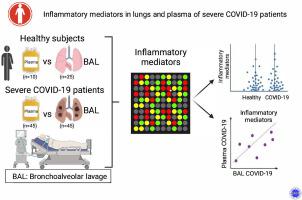Journal of Allergy and Clinical Immunology ( IF 11.4 ) Pub Date : 2021-06-07 , DOI: 10.1016/j.jaci.2021.05.032 Younes Zaid 1 , Étienne Doré 2 , Isabelle Dubuc 3 , Anne-Sophie Archambault 4 , Olivier Flamand 3 , Michel Laviolette 5 , Nicolas Flamand 4 , Éric Boilard 6 , Louis Flamand 7

|
Background
Severe acute respiratory syndrome coronavirus 2 (SARS-CoV-2) infection can lead to a variety of clinical outcomes, ranging from the absence of symptoms to severe acute respiratory disease and ultimately death. A feature of patients with severe coronavirus disease 2019 (COVID-19) is the abundance of inflammatory cytokines in the blood. Elevated levels of cytokines are predictive of infection severity and clinical outcome. In contrast, studies aimed at defining the driving forces behind the inflammation in lungs of subjects with severe COVID-19 remain scarce.
Objective
Our aim was to analyze and compare the plasma and bronchoalveolar lavage (BAL) fluids of patients with severe COVID-19 (n = 45) for the presence of cytokines and lipid mediators of inflammation (LMIs).
Methods
Cytokines were measured by using Luminex multiplex assay, and LMIs were measured by using liquid chromatography–tandem mass spectrometry.
Results
We revealed high concentrations of numerous cytokines, chemokines, and LMIs in the BAL fluid of patients with severe COVID-19. Of the 13 most abundant mediators in BAL fluid, 11 were chemokines, with CXCL1 and CXCL8 being 200 times more abundant than IL-6 and TNF-α. Eicosanoid levels were also elevated in the lungs of subjects with severe COVID-19. Consistent with the presence chemotactic molecules, BAL fluid samples were enriched for neutrophils, lymphocytes, and eosinophils. Inflammatory cytokines and LMIs in plasma showed limited correlations with those present in BAL fluid, arguing that circulating inflammatory molecules may not be a reliable proxy of the inflammation occurring in the lungs of patients with severe COVID-19.
Conclusions
Our findings indicate that hyperinflammation of the lungs of patients with severe COVID-19 is fueled by excessive production of chemokines and eicosanoids. Therapeutic strategies to dampen inflammation in patients with COVID-19 should be tailored accordingly.
中文翻译:

趋化因子和类二十烷酸助长严重 COVID-19 患者肺部的过度炎症
背景
严重急性呼吸系统综合症冠状病毒 2 (SARS-CoV-2) 感染可导致多种临床结果,从没有症状到严重的急性呼吸道疾病和最终死亡。2019 年严重冠状病毒病 (COVID-19) 患者的一个特征是血液中含有丰富的炎性细胞因子。细胞因子水平升高可预测感染严重程度和临床结果。相比之下,旨在确定严重 COVID-19 患者肺部炎症背后驱动力的研究仍然很少。
客观的
我们的目的是分析和比较重症 COVID-19(n = 45)患者的血浆和支气管肺泡灌洗液(BAL)中是否存在细胞因子和炎症脂质介质(LMIs)。
方法
细胞因子使用 Luminex 多重分析法测量,LMI 使用液相色谱-串联质谱法测量。
结果
我们发现重症 COVID-19 患者的 BAL 液中存在高浓度的多种细胞因子、趋化因子和 LMI。在 BAL 液中 13 种最丰富的介质中,11 种是趋化因子,CXCL1 和 CXCL8 的含量是 IL-6 和 TNF-α 的 200 倍。患有严重 COVID-19 的受试者肺部的类二十烷酸水平也升高。与趋化分子的存在一致,BAL 流体样品富含嗜中性粒细胞、淋巴细胞和嗜酸性粒细胞。血浆中的炎症细胞因子和 LMI 与 BAL 液中存在的相关性有限,认为循环炎症分子可能不是重症 COVID-19 患者肺部炎症的可靠代表。
结论
我们的研究结果表明,严重的 COVID-19 患者肺部的过度炎症是由趋化因子和类二十烷酸的过度产生所致。应相应地调整抑制 COVID-19 患者炎症的治疗策略。











































 京公网安备 11010802027423号
京公网安备 11010802027423号